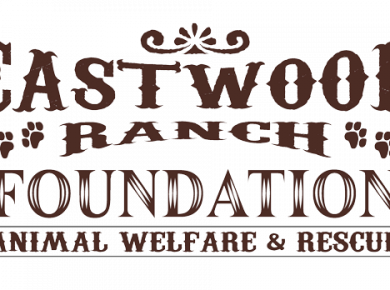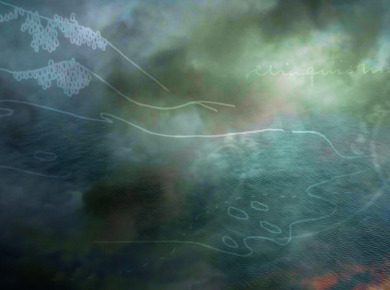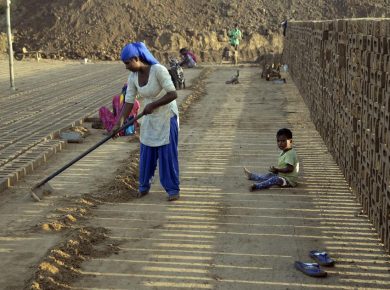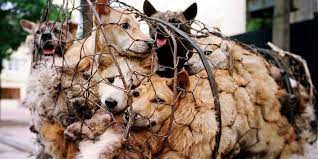
Inglorious death. In the horse yard of the bullring in Azpeitia, a bull is hung by his hind leg to bleed out before being butchered at the local meat works. Photo: Aitor Garmendia.
Late last year, an unflinching new book of photography documenting our relationship with non-human animals was released, featuring the work of 40 international photojournalists and a foreword by Academy Award-winning actor Joaquin Phoenix. HIDDEN: Animals in the Anthropocene exposes the invisible animals in our lives: those we eat and wear, those we use in research and entertainment, and those we sacrifice in the name of tradition and religion. The 320-page collectible hardcover offers more than 200 images spanning six continents. “The photojournalists represented in HIDDEN have entered some of the darkest, most unsettling places in the world,” said Phoenix. “The images they have captured are a searing reminder of our unpardonable behavior towards animals and will serve as beacons of change for years to come.” Below is an interview with HIDDEN co-editors Jo-Anne McArthur and Keith Wilson.
Why the title “HIDDEN?” What’s being hidden? By whom? From whom?
Jo-Anne: The animals we use most in our daily lives are hidden. They’re hidden away in factory farms, fur farms, and in labs that use them in research and testing. They are also hidden euphemistically; we don’t say we’re eating a calf, for example. We say we’re eating veal. And in animal research, an animal is “sac’ed” when they are finished being used. Being killed is called being “sacrificed.” These words sound much more noble. They create space between “human” and “animal,” “us” and “them,” “subject” and “object.”
We are always hiding animals from ourselves. We build walls and euphemisms to cover any discomfort we might have. If we were to face the animals we keep in crates and cages, and spend some time examining their lives there, and why they are there, we may not be able to enjoy ham or foie gras.
In addition to exposing the use of animals, HIDDEN also attempts to break new ground in the growing field of Animal Photojournalism. What is animal photojournalism?
Jo-Anne: Animal Photojournalism (APJ) is an emerging genre of photography that captures, memorializes, and exposes the experiences of animals who live amongst us, but who we fail to see. At its core, the images in this pioneering field document the broader human-animal conflict and its resultant ecosystems of suffering. As global societies collectively awaken to the realities of our unjust exploitation of animals, APJ is of increasing interest.
From public and environmental health crises to zoonotic viruses, animals are inextricably linked to many areas of current global concern, and rightfully so. Our existence is intertwined, and the ethics of how we treat the other sentient beings with whom we share this planet are being called into question. Animal photojournalism aims to encourage swift and necessary change on behalf of the beings in the frame. APJ emphasizes the inclusion of all animals, particularly those historically underrepresented, like those kept within industrialized systems.
APJ is groundbreaking for two reasons. First, images in this genre demand radical empathy and self-awareness. Viewers must de-centre themselves and consider the world through the eyes of a different species, while holding the truth of humanity’s undeniable role in the story. Additionally, it poses a fundamental threat to deeply embedded societal systems that continue, largely unchallenged. The act of seeking out these visual stories is itself an act of resistance.
How is animal photojournalism comparable to war photography?
Keith: It is very comparable in terms of the subject matter, there being victims and oppressors, atrocities and bloodshed. War photography is compelling to many people because it is perceived as both glamorous and dangerous, but let’s not forget that risking your life to photograph a war is ultimately a personal choice. It is the same for much of the animal photojournalism in HIDDEN, but no-one calls it glamorous!
It is certainly dangerous, not so much from stray bullets or IEDs, but from the emotional and mental impact caused by witnessing animal death on a scale that is far greater than from any human conflict. By “any,” I include events of genocide and ethnic cleansing.
Yet society remains impervious to the systematic killing of billions of animals every year because people are more desensitized to the suffering of animals than the suffering of people. HIDDEN aims to change that perspective, in which case animal photojournalists one day will be raised to the same level of respect and acclaim that is afforded to war photographers, some of whom are regarded as legends: photographers like Don McCullin, James Nachtwey, and Larry Burrows. Sadly, “legend” is not a term ascribed to any animal photojournalist, but I believe that day will come. Currently animal photojournalism, unlike war photography, is not a term that is immediately understandable to everyone. HIDDEN will help change that.

A macaque performs in a popular street show in Jakarta, known locally as Topeng Monyet (Mask Monda). Indonesia. Photo: Joan de la Malla.
You and many other photographers have to trespass or break other laws to gain access to the facilities you document. How is this work similar to whistleblowers working within these industries who run afoul of so-called “ag-gag” laws?
Jo-Anne: Animal industries should be transparent because they serve the public, but they are just the opposite, with multi-million dollar lobbying efforts keeping their exploits concealed. Incredibly, they have legislated this. Such is the threat of documentarians and whistleblowers. Concentrated Animal Feeding Operations and other industries that use animals do not want cameras around. The reason for that is simple: when there are cameras, there is documentation of systemic cruelty that many consumers would oppose. Evidence documented inside CAFOs shows cruelty, confinement, abuse, and incredibly rough working conditions for labourers too. The paranoia of the industry is so strong that animal photojournalists who trespass can be charged as terrorists under the U.S. Animal Enterprise Terrorism Act. It’s absurd! And all the more reason to uncover what, and who, is hidden.
What’s the most harrowing or affecting experience you’ve ever had documenting animals in their unnatural environments?
Jo-Anne: It’s not one experience, but the recurring experience of leaving the animals behind, once I’ve taken their photographs. I can’t help the millions of animals I’ve met. I’m trying to change the future for animals. So, the leaving comes with a feeling of guilt. I channel negative and unproductive feelings into action, though, otherwise I would not be able to do this work.
Do you relate to animals individually when documenting these kinds of scenes, or do you stay objective? How do your interactions with individual animals factor into your work?
Jo-Anne: If I closed myself off emotionally to my subject matter, I would not take good photos. I’m fully engaged, and empathetic too. Empathy and compassion drives the work. But I’m also aware that I have very limited time to do the best possible job. Ideal images for me show both individual and context, and so engaging with the individuals who are caught in these industries is essential. If an animal is connecting to me, they will connect to the audience viewing the image. My best images are those when I am up close with a wide angle. The calf in the wheelbarrow, being put into a crate. The rabbit, ears back, visibly next in line for slaughter.
What’s it like to spend your career witnessing animal abuse, cruelty, and neglect? What is the psychological impact?
Jo-Anne: Interestingly enough, that answer may not actually be visible to me. There has been a tremendous amount of psychological impact, both detrimental and galvanizing. Bearing witness only furthers my drive to do it again, and to mentor others to do it, and to build our strategic agency, We Animals Media, that tells the stories of animals. I’m not afraid of confronting the suffering of others, and I am fairly philosophical about my own suffering at this point. It’s my job to go towards these stories, and so I do. It’s very clear to me that we can only change suffering if it’s out in the open and if we don’t turn away from it.
What takes place for people viewing these images? What’s the process of awareness that they go through – or that you hope, ideally, they go through?
Keith: Many of the pictures are blunt and brutal. But we make no apologies for that, because you cannot soften the reality of industrial-scale execution, which is what many of these images depict. So, people will be shocked and hopefully angered by what they see. But I also want them to come away better informed, and not just outraged. We all know that “every picture is worth a thousand words,” but not all those words are answers. In the case of HIDDEN, most of these words are questions, and I’ve always felt that the best documentary pictures are those that raise countless questions in the viewer’s mind. That’s why the supporting text, captions and statistics are so important: they help the viewer to rationalize the horror of what they see.
Raising awareness isn’t just about grabbing people’s attention with a shocking image – that’s only half the story. It’s about converting that emotional response into considered action, based upon the facts that accompany the image.
And so what action do you hope people take once they have new awareness?
Keith: That can vary according to the individual of course. I’m a passionate believer in allowing people to have freedom of choice on as many issues as possible, but some choices are harder than others, in which case it makes sense to argue from an informed position. Unfortunately, our relationship with animals is mired in ignorance and indoctrination from one generation to the next.
I think raising a new awareness about this relationship – which is what HIDDEN brings to the discussion – is like the untying of a blindfold from which the gaining of sight and insight reveals a simple and obvious course of action, one with huge benefits for the whole world. It is this: stop eating animals and always remember that animals should be respected and treated as our equals. If humanity is to survive this century, then the lessons of COVID-19 must surely have taught us that we must coexist sustainably with our fellow creatures, and treat the planet as a living being too. Neither Earth nor her animals should be viewed as endless commodities for our conspicuous consumption.
HIDDEN includes images from all over the world – six continents. Is there a common thread in animal use among different cultures? Are there distinctions?
Keith: There is a common, bloody and stinking thread that remains strong across all continents and cultures – and has done so for thousands of years. This thread is one that connects all animals as a resource, a commodity, for our use and abuse. Across all cultures, we kill and exploit animals to feed us and to clothe us, to help us hunt and travel, to be subjected to experiments and sacrificed in the name of research and tradition, and as subjects for our entertainment.
Distinctions? Apart from the fact that some cultures avoid certain animals from their diet, or give them religious reverence, there are few distinctions I can think of; none that are edifying or noble.
How did you two team up on this project?
Keith: We had worked together before, but indirectly, on a collaborative project called Photographers Against Wildlife Crime. This culminated in a couple of photo books of the same title, which I co-edited, and which were published in 2018 and 2019. Jo-Anne was one of the contributing photographers. Two years ago we were at the book launch and I also interviewed Jo-Anne for a magazine article about her work. Afterwards, she outlined her vision to me for the future about her photography, We Animals Media and the enormity of the task that lay ahead. An important part of that vision was to produce a book of significance about the war on animals, something akin to Salgado’s “Workers” and Nachtwey’s “Inferno.” So, nothing too ambitious! Joking aside, I could immediately see what she was attempting and the scale of her ambition. It was challenging, risky and different. I like those sorts of challenges, so I became interested very quickly.

Who’s next? At this dog slaughterhouse, a butcher chooses the dog he will beat to death with an iron bar while the other dogs look on. China. Photo: Jose Valle.
What made you want to collaborate on HIDDEN? Was this experience different from other book projects in nature and conservation photography?
Keith: I’ve met and interviewed hundreds of photographers across all disciplines and I like to think I’ve become adept at quickly seeing the character of the person beneath the public face that is presented to others. From the outset, I knew Jo-Anne would be someone I could work with in a very open and honest way, while also putting up with my terrible adherence to deadlines and questionable sense of humour.
Compared to other book projects I have edited, HIDDEN is easily the most intense in terms of the production scale, number of contributors, and the subject matter. In many ways, it has proven to be a perfect follow-up to Photographers Against Wildlife Crime, because that was also a collection of photo stories by dozens of photographers raising awareness about an issue – in this case, the illegal wildlife trade – that has been overlooked and ignored for too long. Interestingly, seven of the photographers from that book have contributed to HIDDEN too.
Working on HIDDEN has shown me that our terrible treatment of all animals, whether farmed or wild, is at the centre of our own malaise. It was ironic that the outbreak of COVID-19 coincided with the production of the book, and this has served to show that HIDDEN is an absolutely essential book of this era. For me, there is no better reason to be working on a book than one that is as relevant to our times, or as needed, as HIDDEN has proven to be.
How did you select and narrow down the photojournalists, and choose what work to include in the book?
Keith: It was a slog, simply because we both wanted to be thorough while also adhering to a photographically high quality threshold. We lost count of how many images we trawled and downloaded, searched and sent requests for. Some images stood out immediately and were fairly straightforward to source, but others took weeks to track down. In particular, it was easier to find video footage of live pig burials and duck burials than high-resolution still photographs. Constructing photo stories in the sequence that we agreed on took longer than anticipated. Purely from a photographic perspective, there were so many superb examples that hundreds of photos were excluded with huge reluctance. [Designer] David Griffin provided that objective, yet all-important, viewpoint on aesthetics to create the book’s great layout. Also it was a difficult edit mentally and emotionally, and sometimes I had to walk away from the layouts. It’s impossible to forget that all the animals in a photograph, and on every page in HIDDEN, are now dead.
Jo-Anne: I’d been watching a lot of the contributing photographers for a long time, so I had a list of people and work that I wanted included in the book. We also reached out to individual photographers who had shot exceptional stories, or who were in the field while we were making the book. Keith mentioned the duck burial image. I had seen that image years ago and had squirrelled it away – and many others too – in a folder for the animal photojournalism book I would make one day.
And how did Joaquin Phoenix get on board? How did you get to know him?
Jo-Anne: Joaquin and I had met a few times over the past year when we were both at events in support of animal activism in Canada, the U.S., and in England. We both bear witness to animals going to slaughter and we are fans of each other’s activism and work. I told him about the book and was absolutely delighted by his response that he’d be honoured to write something for HIDDEN. I think it’s always great when people of influence use that influence to benefit others. Joaquin and his partner Rooney are role models in that regard.
Why did you choose to publish under We Animals Media via crowdfunding versus a traditional publisher? The amount raised was significant.
Jo-Anne: Yes, it was! We carefully crunched numbers and landed on $65,000 Canadian. It’s a large amount and we were worried we wouldn’t meet the goal, but we did in three and a half days. By the end of the campaign, we’d received $200,000 in support. We’re driving these funds back into the book, and investing in future shoots with the contributing photographers as well. We Animals Media has always had a donor-based business model. It’s working; people are investing in us and in our projects – in some cases overwhelmingly so like with this book – because it’s work that is necessary, and so crucial at this point in history.
We Animals Media is made up of very smart and passionate people. We are problem-solvers, so I knew the best course of action would be to drive this bus ourselves, much like our other projects. It’s about working with talented and committed people who think outside the box. We were approached by a few publishers but ultimately we felt we could do the most in house, with a ton of advice, of course! It takes a village.






